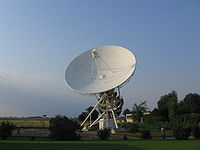
Torun Centre for Astronomy
Encyclopedia


Radio
Radio is the transmission of signals through free space by modulation of electromagnetic waves with frequencies below those of visible light. Electromagnetic radiation travels by means of oscillating electromagnetic fields that pass through the air and the vacuum of space...
observatory
Observatory
An observatory is a location used for observing terrestrial or celestial events. Astronomy, climatology/meteorology, geology, oceanography and volcanology are examples of disciplines for which observatories have been constructed...
located at (53°5′42.9"N 18°33′45.9"E) near about 15 km north of Toruń
Torun
Toruń is an ancient city in northern Poland, on the Vistula River. Its population is more than 205,934 as of June 2009. Toruń is one of the oldest cities in Poland. The medieval old town of Toruń is the birthplace of the astronomer Nicolaus Copernicus....
, Poland
Poland
Poland , officially the Republic of Poland , is a country in Central Europe bordered by Germany to the west; the Czech Republic and Slovakia to the south; Ukraine, Belarus and Lithuania to the east; and the Baltic Sea and Kaliningrad Oblast, a Russian exclave, to the north...
. It houses two single-dish antenna
Antenna (radio)
An antenna is an electrical device which converts electric currents into radio waves, and vice versa. It is usually used with a radio transmitter or radio receiver...
telescopes, 32 metres and 15 metres in diameter
Diameter
In geometry, a diameter of a circle is any straight line segment that passes through the center of the circle and whose endpoints are on the circle. The diameters are the longest chords of the circle...
, as well as the largest Polish optical telescope - 90-cm Schmidt-Cassegrain camera. The facility is operated by the Nicolaus Copernicus University. Also, photometry using 60-cm Cassegrain telescope is made and radio measurements of the Sun at 127 MHz frequency are recorded on a daily basis since 1958 using 23m interferometer.
Radio astronomy
Since 1981 the observatory has been a part of world wide network of radio telescopeRadio telescope
A radio telescope is a form of directional radio antenna used in radio astronomy. The same types of antennas are also used in tracking and collecting data from satellites and space probes...
s participating in VLBI (Very Long Baseline Interferometry). The 32 m telescope is a 620-ton construction designed by Zygmunt Bujakowski based on initial geometric parameters created by Dr Jerzy Usowicz. It is used in VLBI experiments, as well as spectroscopic, flux, polarisation measurements and pulsar
Pulsar
A pulsar is a highly magnetized, rotating neutron star that emits a beam of electromagnetic radiation. The radiation can only be observed when the beam of emission is pointing towards the Earth. This is called the lighthouse effect and gives rise to the pulsed nature that gives pulsars their name...
observations. Currently receivers for frequencies 1.4-1.8GHz, 5 GHz, 6.5GHz, 10.8 GHz and 30 GHz are in use.
The 15-m telescope is used for training students of the Nicolaus Copernicus University.
The observatory's role as a VLBI station is unique in central/eastern Europe. International collaboration and involvement in various European research projects is the major activity of this department. The research concentrates on observations and theoretical interpretation of physical processes in compact active regions of radio galaxies and quasars, observational cosmology
Observational cosmology
Observational cosmology is the study of the structure, the evolution and the origin of the universe through observation, using instruments such as telescopes and cosmic ray detectors.-Early observations:...
, the timing of pulsars, the search for new planetary systems and Solar System
Solar System
The Solar System consists of the Sun and the astronomical objects gravitationally bound in orbit around it, all of which formed from the collapse of a giant molecular cloud approximately 4.6 billion years ago. The vast majority of the system's mass is in the Sun...
studies. In addition, the development of instrumentation for radio astronomy (ultra low noise receivers, spectrometers, frequency converters, digital electronics, control systems) is also a significant part of activities in the observatory. Since 1997 the Department of Radio Astronomy has been a part of Toruń
Torun
Toruń is an ancient city in northern Poland, on the Vistula River. Its population is more than 205,934 as of June 2009. Toruń is one of the oldest cities in Poland. The medieval old town of Toruń is the birthplace of the astronomer Nicolaus Copernicus....
Centre for Astronomy at the Faculty of Physics, Astronomy and Applied Informatics of the Nicolaus Copernicus University in Toruń
Nicolaus Copernicus University in Torun
Nicolaus Copernicus University in Toruń is located in Toruń, Poland. It was named after Nicolaus Copernicus who was born in this town in 1473.-The beginnings of higher education in Toruń:...
. From 1998 the department has undertaken the additional function of a National Facility with a major aims of serving Polish astronomers and emphasizing international cooperation.
WASP-3c & TTV
Transit Timing Variation (TTV), a variation on the transit method, was used to discover a exoplanet WASP-3c by Rozhen ObservatoryRozhen Observatory
Rozhen Observatory is a Bulgarian astronomical observatory, located 90 km south of the city of Plovdiv, Bulgaria. The nearest town, Chepelare, is 15 km away. It is owned and operated by the Institute of Astronomy of the Bulgarian Academy of Sciences. The Observatory is one of the largest in Europe...
, Jena Observatory
Jena Observatory
Astrophysikalisches Institut und Universitäts-Sternwarte Jena is an astronomical observatory owned and operated by Friedrich Schiller University of Jena...
, and Toruń Centre for Astronomy
Torun Centre for Astronomy
The Toruń Centre for Astronomy is an optical and radio observatory located at near about 15 km north of Toruń, Poland. It houses two single-dish antenna telescopes, 32 metres and 15 metres in diameter, as well as the largest Polish optical telescope - 90-cm Schmidt-Cassegrain camera. The facility...
.

